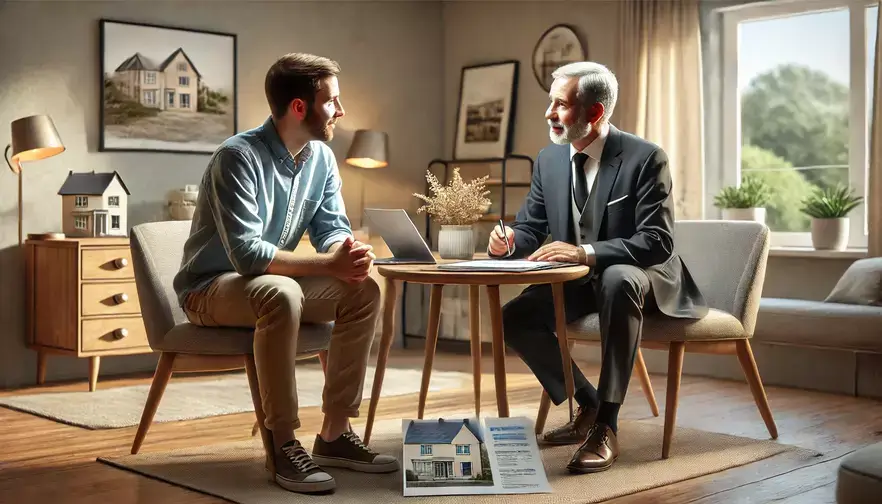Step 1: Deciding to Sell
Assessing Market Conditions
Before you put your home on the market, it's crucial to understand the current market conditions. Is it a buyer's market or a seller's market? In a seller's market, there are more buyers than available properties, which can drive up prices. In a buyer's market, there are more properties than buyers, which can mean lower prices and longer time on the market.
Understanding these conditions can help you decide the best time to sell. You can gather this information by looking at local housing reports, talking to real estate professionals, or using online resources that track housing market trends.
Evaluating Personal Circumstances
Consider your personal reasons for selling. Are you relocating for work, downsizing, or upsizing? Understanding your motivation will help you make decisions throughout the process. If you're moving for a job, your timeline might be more urgent. If you're downsizing, you might have more flexibility.
Think about how this move fits into your long-term plans. Are you looking to move closer to family, seeking a new adventure, or simply looking for a change? Clarifying your reasons can help you stay focused and make the right decisions as you move forward.
Financial Considerations
Examine your financial situation. Calculate the potential sale price of your home, your outstanding mortgage balance, and the costs involved in selling and buying another property. This will help you determine if now is the right time to sell.
Consider consulting with a financial advisor to get a clear picture of your financial health and how selling your home will impact your overall financial situation. This can include understanding capital gains taxes, potential costs for repairs and staging, and moving expenses.
Step 2: Preparing Your Home for Sale
Declutter and Depersonalize
Start by removing personal items and excess furniture to make your home look more spacious. Potential buyers need to imagine themselves living in your home, so creating a neutral, clutter-free environment is essential.
Consider renting a storage unit temporarily if you need to store excess items. This can help create a more open and inviting space without permanently getting rid of belongings you might need later.
Clean and Repair
A clean, well-maintained home appeals to buyers. Deep clean every room, fix minor repairs like leaky faucets, cracked tiles, and peeling paint. A fresh coat of neutral paint can make your home more inviting.
Don't overlook small details like cleaning the grout in your tiles, replacing burnt-out light bulbs, and fixing squeaky doors. These small fixes can make a big difference in how your home is perceived.
Stage Your Home
Staging highlights your home's best features. Consider rearranging furniture, adding some tasteful decorations, or even hiring a professional stager. Staging can make a significant difference in how buyers perceive your property.
Professional stagers can help create a cohesive look that appeals to a broad range of buyers. They can provide furniture and décor that enhance your home's features and create a welcoming atmosphere.
Enhance Curb Appeal
First impressions matter. Ensure the exterior of your home is inviting by tidying up the garden, cleaning windows, and possibly repainting the front door. A well-maintained exterior can attract more buyers.
Simple improvements like mowing the lawn, planting flowers, and power washing the driveway can greatly enhance your home's curb appeal. Consider adding outdoor lighting and ensuring your house number is visible and attractive.
The Importance of a Home Inspection
Consider getting a pre-sale home inspection. This can identify any potential issues that buyers might bring up later. Addressing these issues upfront can prevent surprises during the sale process and give buyers confidence in the condition of your home.
A home inspection can cover the roof, foundation, plumbing, electrical systems, and more. By addressing any major issues before listing your home, you can avoid last-minute negotiations or losing a potential buyer.
Step 3: Choosing the Right Estate Agent
Research and Compare
Look for estate agents with good reviews and a strong track record in your area. Compare their services, fees, and marketing strategies. Websites like helloagent can help you compare local estate agents based on independent analysis.
Use online resources, ask for recommendations from friends and family, and attend open houses to see agents in action. Look for agents who are knowledgeable, professional, and have a strong online presence.
Interview Multiple Agents
Meet with at least three agents to discuss your property and their approach to selling homes like yours. Ask about their experience, marketing plans, and how they handle negotiations.
During these interviews, pay attention to how the agents communicate with you. Are they listening to your needs and concerns? Do they have a clear strategy for selling your home? This interaction can give you a good sense of what it will be like to work with them.
Ask the Right Questions
- How will you market my property?
- What price do you think my home will sell for and why?
- What are your fees?
- How often will you provide updates?
These questions can help you understand the agent's approach and whether it aligns with your expectations. Don't hesitate to ask for references from previous clients.
Check Their Credentials
Ensure the estate agent is registered with a professional body such as the National Association of Estate Agents (NAEA) or the Royal Institution of Chartered Surveyors (RICS). This adds a level of credibility and professionalism.
Also, check if the agent has any additional certifications or training that can be beneficial, such as expertise in luxury homes, eco-friendly properties, or investment properties.
Step 4: Setting the Right Price
Get a Valuation
Most estate agents offer a free valuation service. Consider getting valuations from multiple agents to get a range of opinions. An accurate valuation is crucial for setting a competitive price.
Valuations should take into account the current market conditions, the condition of your home, and comparable properties in your area. A well-priced home can attract more interest and offers.
Research the Market
Look at similar properties in your area that have recently sold. This can give you an idea of what buyers are willing to pay. Websites like Rightmove and Zoopla can be helpful.
Pay attention to how long similar properties stayed on the market and any price reductions that occurred. This can give you insights into how competitive your pricing needs to be.
Consider the Current Market Conditions
If it's a seller's market, you might be able to price your home higher. In a buyer's market, you may need to be more competitive to attract buyers.
Monitor local news and real estate reports to stay informed about market trends. Understanding the broader economic factors affecting the housing market can also be beneficial.
Be Realistic
Be honest about your property's condition and location. Overpricing can lead to your home sitting on the market for too long, which can make it less attractive to buyers. A realistic price can generate more interest and potentially lead to a quicker sale.
Consider pricing strategies such as setting a slightly lower price to attract multiple offers or pricing at market value to appeal to a broader range of buyers.
Step 5: Marketing Your Property
Professional Photography
High-quality photos are essential as they are often the first thing potential buyers see. Ensure your home is clean and well-lit for the photo shoot. Professional photography can make your listing stand out.
Consider including aerial shots or virtual tours to provide a comprehensive view of your property. These can be particularly appealing in the current digital age where buyers often start their search online.
Online Listings
Your property should be listed on major property websites like Rightmove, Zoopla, and OnTheMarket. Include a detailed description, high-quality photos, and key features. A well-crafted listing can attract more interest.
Ensure your listing highlights the unique features of your home, such as a large garden, modern kitchen, or proximity to good schools. Use descriptive language to paint a picture for potential buyers.
Social Media
Many estate agents use social media platforms to reach a wider audience. This can include paid ads and organic posts. Sharing your listing on social media can increase visibility.
Consider using Facebook, Instagram, and LinkedIn to showcase your property. You can also create short videos or live tours to engage with potential buyers directly.
Open Houses
Hosting an open house can generate interest and allow multiple buyers to view your property at once. Open houses can create a sense of urgency and competition among buyers.
Promote your open house through online listings, social media, and local advertisements. Ensure your home is in top condition and provide refreshments to create a welcoming atmosphere.
Signage and Print Advertising
Don't underestimate the power of traditional methods like signage and print advertising. A well-placed "For Sale" sign can attract local buyers who might be interested. Additionally, listing your property in local newspapers or real estate magazines can reach a different audience.
Engage with Real Estate Influencers
Consider collaborating with local real estate influencers or bloggers who can feature your property on their platforms. This can increase your reach and attract more potential buyers.
Step 6: Managing Viewings
Schedule Flexibly
Try to be flexible with viewing times to accommodate potential buyers' schedules. The more accessible your home is, the more potential buyers can view it.
Consider offering evening or weekend viewings to accommodate buyers who work during the day. Flexibility can make your home more attractive to a broader range of buyers.
Prepare Your Home
Before each viewing, ensure your home is clean, tidy, and well-ventilated. Remove any personal items and make the space as neutral as possible. A welcoming atmosphere can leave a positive impression.
Add finishing touches like fresh flowers, scented candles, or soft music to create a pleasant environment. Small details can make a big difference in how buyers perceive your home.
Provide Information
Have information about your property and the local area available for viewers. This can include details about schools, transport links, and amenities. Providing useful information can help buyers make a decision.
Create a property brochure that highlights key features and includes high-quality photos. This can be a useful takeaway for buyers after the viewing.
Stay Out of the Way
Allow the estate agent to conduct the viewing and answer questions. This gives buyers the freedom to explore and envision themselves living in your home without feeling pressured.
If possible, take pets out of the house during viewings to avoid distractions. Ensure that any pet-related odours are minimised.
Step 7: Receiving and Negotiating Offers
Review All Offers
Consider all offers carefully, not just the highest one. Look at the buyer's situation, such as whether they are a cash buyer or have a mortgage in principle. A reliable buyer can sometimes be more valuable than a higher offer.
Ask your estate agent for a comparative market analysis to understand the value of the offers. Consider the contingencies and timelines associated with each offer.
Negotiate
Don't be afraid to negotiate. Your estate agent can help you get the best possible price and terms. Negotiation is a normal part of the selling process, and it can lead to a better deal.
Understand your bottom line and be prepared to make counteroffers. Be open to negotiating terms beyond the price, such as the closing date or contingencies.
Accepting an Offer
Once you've agreed on an offer, it's time to formalise the agreement. Your estate agent will help with this process, ensuring that all terms are clear and legally binding.
Ensure all agreements are put in writing and signed by both parties. This includes the sale price, contingencies, and any special conditions.
Step 8: Conveyancing and Legal Processes
Hire a Solicitor or Conveyancer
Choose a qualified solicitor or licensed conveyancer to handle the legal aspects of your sale. They will ensure that all legal requirements are met.
Research and compare solicitors to find one with good reviews and reasonable fees. Your estate agent may also have recommendations.
Drafting Contracts
Your solicitor will draft the contract of sale, which includes details about the property, the price, and any conditions of the sale. This contract is crucial for the legal transfer of ownership.
Review the contract carefully and ensure all terms are accurate. Your solicitor can explain any legal jargon and ensure your interests are protected.
Searches and Enquiries
Your solicitor will conduct searches to check for any issues that could affect the property's value or use. These searches include local authority searches, environmental searches, and more.
Respond promptly to any enquiries from the buyer's solicitor. Delays in providing information can slow down the sale process.
Exchange of Contracts
Once both parties are satisfied, contracts are exchanged, and the sale becomes legally binding. At this point, a deposit is usually paid, and a completion date is set.
Ensure you understand the timeline for completion and any remaining steps. This is a good time to finalise your moving arrangements.
Completion
Completion is when the remaining money is transferred, and you hand over the keys to the buyer. This is the final step in the selling process, and it marks the official transfer of ownership.
Ensure all utilities are switched off and keys are handed over as agreed. Congratulations, you've sold your home!
Step 9: Moving Out
Final Steps
- Confirm the moving date with all parties involved.
- Notify utility companies and service providers about your move.
- Redirect your mail to your new address.
Create a moving checklist to stay organised and ensure nothing is forgotten. This can include tasks like updating your address with banks and subscriptions.
Moving Day
Ensure your home is clean and all your belongings are removed before the completion date. Being organised on moving day can make the transition smoother.
Consider hiring professional movers to make the process easier. Label boxes clearly and create an inventory to keep track of your belongings.
Non-Typical Circumstances
Selling a home isn't always straightforward. Here are some non-typical circumstances you might encounter:
Selling a Leasehold Property
Ensure you understand the terms of your lease and any permissions needed from the freeholder. Selling a leasehold property can involve additional steps and considerations.
Discuss the terms with your solicitor and ensure you provide potential buyers with all necessary information about the lease.
Selling a Shared Ownership Property
Check the terms of your agreement and inform your housing association. Shared ownership properties have specific rules and regulations that must be followed.
Your housing association may have the right to find a buyer before you can sell on the open market. Understand these rules to avoid delays.
Selling an Inherited Property
Consider the emotional aspects and the legal implications, such as probate. Selling an inherited property can be complex and may require additional legal steps.
Consult with a solicitor to navigate the probate process and understand any tax implications. Consider the emotional impact and give yourself time to make decisions.
Selling Due to Financial Difficulty
Seek advice on the best course of action, which may include speaking to your lender. If you're selling due to financial hardship, there may be options available to help you.
Consider options like a short sale or negotiating with your lender to avoid foreclosure. Seek professional advice to understand your options and make informed decisions.
FAQs
How long does it take to sell a home? The timeline can vary, but on average, it takes around 2-3 months from listing to completion.
What are the costs involved in selling a home? Costs can include estate agent fees, solicitor fees, and potential costs for repairs or staging.
Can I sell my home without an estate agent? Yes, you can sell your home privately, but it requires more effort and knowledge of the process.
What should I do if my home isn't selling? Consider adjusting the price, improving your home's presentation, or changing your marketing strategy.
What is the role of a conveyancer? A conveyancer handles the legal aspects of transferring property ownership. They conduct searches, draft contracts, and ensure all legal requirements are met.
Can I change my mind after accepting an offer? Yes, you can change your mind until contracts are exchanged. After the exchange of contracts, the sale is legally binding.
Selling your home can be a complex process, but with the right knowledge and preparation, you can achieve a successful sale. If you have any questions or need further assistance, feel free to reach out to us at helloagent. Happy selling!




